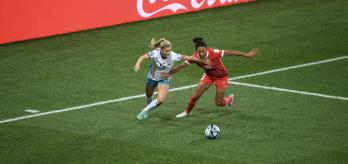Key points
-
The physicality of women’s football has accelerated rapidly in the last decade, particularly the speed and intensity of match play.
-
For the first time, the physical data from the FIFA Women’s World Cup™ was linked with FIFA’s Enhanced Football Intelligence metrics to add much-needed context.
-
This information could be valuable to benchmark the current demands of women’s international football, while also providing a framework to design female-specific training drills.
Introduction
Beyond Greatness™ was the slogan used for the FIFA Women’s World Cup Australia & New Zealand 2023™ and the tournament did not disappoint. In fact, it raised a bar that was already set very high at the previous FIFA Women’s World Cup™ – held in France in 2019 – to an entirely new level. This was especially true on the pitch, as teams produced arguably the highest standard of football ever witnessed in the women’s game, in both technical and tactical terms. One area of performance that has evolved exponentially in the women’s game over the last decade is the physicality of match play. For example, the amount of high-intensity running increased by around 20% between Canada 2015 and France 2019.1
Given such accelerated rates of physical development, it is crucial that the physical demands of contemporary competitions such as the FIFA Women’s World Cup 2023™ be analysed and documented. The findings from such analyses could be valuable to benchmark the current demands of international match play, while also providing a conceptual framework for the development of female-specific training drills.2-5 To offer practitioners more nuanced and actionable insights, this analysis has been layered with context throughout to add a narrative to the trends (e.g. by highlighting pertinent examples and considering the interplay between the physical data and various contextual and tactical factors).
Methodology
Match analysis system and speed zones
All 64 games during the FIFA Women’s World Cup Australia & New Zealand 2023 were analysed using a multi-camera optical tracking system (TRACAB, ChyronHego, Sweden). All player movements were captured by high-definition cameras operating at 25Hz. The validity of this system has been quantified by FIFA to verify the capture process and the subsequent accuracy of the data.6 After system calibration and various stringent quality control processes, the data captured was analysed using match analysis software. This produced a data set on each team’s and player’s activity pattern during a match using the female-specific speed zones below (Figure 1).
Physical metrics and tournament comparisons
This analysis primarily reported three main physical metrics that provide insights into the volume (total distance) and the intensity of match play (high-intensity and sprint distance). Total distance represented the sum of the distances covered in all speed zones. High-intensity activity consisted of the aggregation of Zones 4 and 5 (>19.0km/h), while sprinting exclusively included Zone 5 activity (>23.0km/h). Although the speed zones used for the FIFA Women’s World Cup 2023 were identical to those employed at Canada 2015 and France 2019, a different optical tracking system (STATS LLC, USA) was in place at the previous tournaments.
This greatly complicates comparisons with previous tournaments.1 Therefore, no comparisons between tournaments have been made using the absolute distances covered (i.e. metres or kilometres). Instead, comparisons have been based solely on the relative proportion of activity in the various zones for within tournament trends across position (e.g. Zone 5 activity as a percentage of total distance). Nevertheless, the reader should still be cognisant of the numerous caveats associated with comparing data from different optical tracking systems (e.g. there may be discrepancies between the speed-zone filters and capture speeds).
Associations between physical and tactical metrics
To further contextualise the physical trends, FIFA’s Enhanced Football Intelligence metrics were also adopted – specifically, the phase-of-play metrics that captured teams’ tactical patterns during games. FIFA’s algorithm quantified different in-possession phases (build-up, progression, final third, attacking transition, counter-attack, long ball and set piece) and out-of-possession phases (low, mid, high block/press, counter-press, recovery and defensive transition) using the tracking data from the previously described system. It used various features (spatial and physical) to identify and classify the different phases of play.
For instance, it extracted ball and player pitch locations in relation to each other, in addition to the speed and direction of play. If teams entered a certain phase of play for a selected period of time, the algorithm recorded this as a frequency count or an accumulated fraction of in-possession or out-of-possession time. The various definitions used to quantify both in-possession and out-of-possession phases of play are explained by FIFA’s Chief of Global Football Development, Arsène Wenger, in the video below. Detailed definitions of all in-possession and out-of-possession phases of play can also be found in freely available documentation.7
Analysis levels
Progression across various levels of complexity
To aid the reader’s understanding of the physical trends, the data has been presented across various levels of complexity. For starters, some basic physical benchmarks of teams and positions at the FIFA Women’s World Cup Australia & New Zealand 2023 are outlined. These trends are subsequently examined across various periods of time (e.g. half by half), before peeling away the complex layers associated with contextual and tactical influences. A graded progression from the basics to more advanced content will hopefully aid the reader’s interpretation of such complex data. This structure will enable practitioners to benchmark performances and more importantly, gain insights into the potential factors that could up- or downregulate physical outputs at team and positional levels.
Team and positional analyses
Team analyses involved the summation of all match physical performance values of outfield players who participated in games, including substitutes (i.e. no goalkeeper data was included). Thus, data trends comprised the sum of all individual outfield player values presented as team totals. Positional analyses involved the examination of the match physical performances of individual players in various tactical roles in the team. For the first time in the women’s game, the data provider assigned eight different outfield tactical roles to enable positional differences to be determined. Only players who completed the entire match were evaluated in positional analyses. All analyses were performed on match data collected over the duration of a normal match plus added time, but no extra-time data was included. This format was used to fall in line with the physical analyses conducted for the previous two editions of the FIFA Women’s World Cup (Canada 2015 and France 2019), in addition to the FIFA World Cup Qatar 2022™.1,8
References
-
FIFA, Physical Analysis of the FIFA Women’s World Cup France 2019™, 2020. Available at: img.fifa.com/image/upload/zijqly4oednqa5gffgaz.pdf. Accessed January 2024.
-
Andersson HA, Randers MB, Heiner-Møller A, Krustrup P & Mohr M. Elite female soccer players perform more high-intensity running when playing in international games compared with domestic league games. Journal of Strength and Conditioning Research. 2010, 24(4): 912-919.
-
Krustrup P, Mohr M, Ellingsgaard H & Bangsbo J. Physical Demands during an Elite Female Soccer Game: Importance of Training Status. Medicine & Science in Sports & Exercise. 2015, 37(7): 1242-1248.
-
Bradley PS & Vescovi J. Velocity thresholds for women’s soccer matches: sex specificity dictates high-speed running and sprinting thresholds – Female Athletes in Motion (FAiM). International Journal of Sports Physiology and Performance. 2015, 10(1): 112-116.
-
Bradley PS, Dellal A, Mohr M, Castellano J & Wilkie A. Gender differences in match performance characteristics of soccer players competing in the UEFA Champions League. Human Movement Science. 2014, 33: 159-171.
-
FIFA. Electronic Performance and Tracking Systems Test Report: Tracab. 2022. Available at: www.fifa.com/technical/football-technology/resource-hub?id=6f21700665d54b3e993a063e9cda109e. Accessed September 2023.
-
FIFA, EFI explanation documents, 2022. Available at: www.fifatrainingcentre.com/en/fwc2022/efi-metrics/efi-metrics-pdfs.php. Accessed January 2024.
-
FIFA, A contextualised physical analysis of the FIFA World Cup Qatar 2022™: quantifying the “what”, “when”, “how” and “why”, 2023. Available at: www.fifatrainingcentre.com/en/fwc2022/physical-analysis/background-and-method.php. Accessed January 2024.













